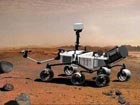| Videos | ? Latest |
|
? Feature | ? Sports | ? Your Videos |
NASA unveils its newest Mars rover

One of the goals of Curiosity is to determine whether Mars ever had an environment capable of supporting life. To that end, the rover will be focussed primarily on the detailed study of Martian rock. John Grotzinger, JPL's lead scientist on the project, says the rover is well equipped for its mission.
John Grotzinger, Lead Scientist, Mars Scientise Laboratory, said, "I think there's going to be one instrument which a lot of people will be interested in, certainly in terms of how it works. It's a laser and it's powerful enough so that distances up to about 7 metres or roughly 20 feet. It burns a small hole in the rock and when that happens, it will happen several times a second and so it will look like a rapid fire sparking in the distance. It's not going to be a big explosion but it's going to be a sparking of a little tiny rock. So it's going to be like doing graffiti on Mars. And then from that you get the composition of the rock. And then we'll know if we want to study it in more detail."
NASA expects the new Rover to be operational for a full Martian year or about two Earth years, thanks to an onboard plutonium based nuclear battery.
With all of the improvements NASA scientist believe Curiousity will have be able to travel farther and faster than previous rovers, while providing the best data yet from the Red Planet.
Go to Forum >>0 Comments
 Add your comments...
Add your comments...
- User Name Required
- Your Comment
- Racist, abusive and off-topic comments may be removed by the moderator.
 0
0 







